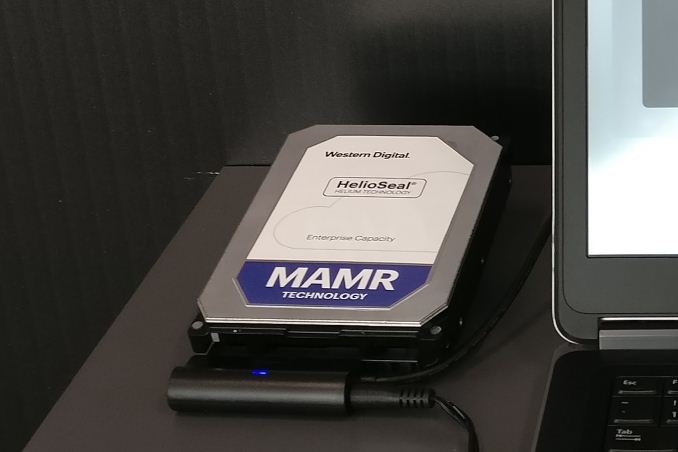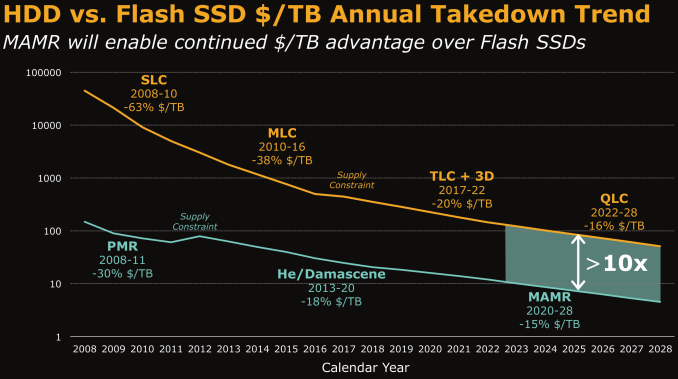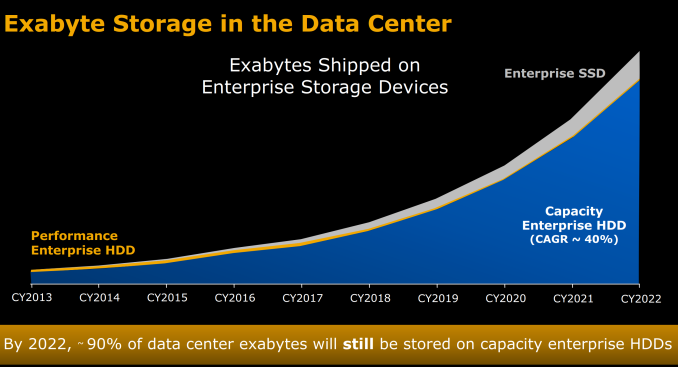Western Digital Stuns Storage Industry with MAMR Breakthrough for Next-Gen HDDs
by Ganesh T S on October 12, 2017 8:00 AM EST
Yesterday, Western Digital announced a breakthrough in microwave-assisted magnetic recording (MAMR) that completely took the storage industry by surprise. The takeaway was that Western Digital would be using MAMR instead of HAMR for driving up hard drive capacities over the next decade. Before going into the specifics, it is beneficial to have some background on the motivation behind MAMR.
Hard drives may be on the way out for client computing systems, but, they will continue to be the storage media of choice for datacenters. The Storage Networking Industry Association has the best resources for identifying trends in the hard drive industry. As recently as last year, heat-assisted magnetic recording (HAMR) was expected to be the technology update responsible for increasing hard drive capacities.

Slide Courtesy: Dr.Ed Grochowski's SNIA 2016 Storage Developer Conference Presentation
'The Magnetic Hard Disk Drive: Today’s Technical Status and Its Future' (Video, PDF)
Mechanical Hard Drives are Here to Stay
One of the common misconceptions amongst readers focused on consumer technology relates to flash / SSDs rendering HDDs obsolete. While using SSDs over HDDs is definitely true in the client computing ecosystem, it is different for bulk storage. Bulk storage in the data center, as well as the consumer market, will continue to rely on mechanical hard drives for the foreseeable future.
The main reason lies in the 'Cost per GB' metric.
Home consumers are currently looking at drives to hold 10 TB+ of data, while datacenters are looking to optimize their 'Total Cost of Ownership' (TCO) by cramming as many petabytes as possible in a single rack. This is particularly prevalant for cold storage and archival purposes, but can also expand to content delivery networks. Western Digital had a couple of slides in their launch presentation yesterday that point towards hard drives continuing to enjoy this advantage, thanks to MAMR being cost-effective.
Despite new HDD technology, advancements in solid state memory technology are running at a faster pace. As a result SSD technology and NAND Flash have ensured that performance enterprise HDDs will make up only a very minor part of the total storage capacity each year in the enterprise segment.
The projections presented by any vendor's internal research team always need to be taken with a grain of salt, but given that SanDisk is now a part of Western Digital the above market share numbers for different storage types seem entirely plausible.
In the next section, we take a look at advancements in hard drive technology over the last couple of decades. This will provide further technical context to the MAMR announcement from Western Digital.












127 Comments
View All Comments
AbRASiON - Thursday, October 12, 2017 - link
Ok great, but when can I buy a 10, 12 or 14TB drive for under 220$ US? :(Zim - Thursday, October 12, 2017 - link
Where is the comment from the person who made $1000's last month working from home? Maybe she's sick or had an accident. I'd sleep more soundly if someone could look in on her. Thanks!Magichands8 - Thursday, October 12, 2017 - link
AIDSArbie - Thursday, October 12, 2017 - link
@Zim +3trivor - Thursday, October 12, 2017 - link
If you are setting up your own video server and have 100s or even 1,000s of video files (currently only 480P, 720P, and 1080P) then I expect to fill up my 8 TB HD in a couple more years. That doesn't include any 4K video (which may include 1.5 Mbit (or more) audio in lossless formats like Atmos, DTS-MA, DD True HD). If you don't currently do it (or only have a few ITunes or XBox Video downloads) you don't know what you are missing. My wife refuses to watch a video unless it has been digitized and all "extra" intro and credits have been removed. When we watch videos it is always from hi quality rips (for the most part the video quality is high enough to be "almost indistinguishable from originals). That usually translates into 4 GB/hour of 1080P, 1 GB/hour of 720P/480P video and audio. While it may not satisfy audiophiles it looks quite nice on my brand new LG 55OLEDB6 which is generally considered to be one of the finest TVs on the market right now. I have been far less tolerant of low quality content (especially older DVD rips of 480P (or lower in some cases) than ever before even though the LG TV does an outstanding job of upscaling lower quality content to 4K (3840x2160P).foobaz - Thursday, October 12, 2017 - link
You are very lucky to have a wife who appreciates and benefits from your hobby. :-)someonesomewherelse - Saturday, October 14, 2017 - link
You're overestimating the time it takes to fill up. I have a 13.58 TB btrfs array which is already at 11.80 TB usage and it's less than a year old. I try to only use 1080p x265 encodes but these aren't always available.mazz7 - Thursday, October 12, 2017 - link
A very nice interesting article, anandtech ftw to educate tech enthusiast :)stux - Thursday, October 12, 2017 - link
Enjoyed the article. Thanks :)AnTech - Friday, October 13, 2017 - link
Bring SSD (faster, larger and cheaper). Once you try SSD, you do not want rotational mechanical disks, even for free!